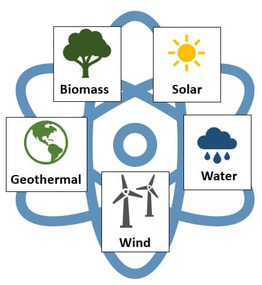|
|
UNIT 2: Biosphere &
11 days
Existence in the world is made up of living and non-living things. Both have to co exist in order to share the resources that are available within the environmental ecosystem. The understanding of this mutual co-relationship is ecology. We are all part of the Ecosystem. The study of ecosystem is important for Environmental Conservation, Resource Allocation, reduce pollution and destruction of ozone layer. |
NC STANDARDS
EEn.2.5.5 Explain how human activities affect air quality.
EEn.2.7.1 Explain how abiotic and biotic factors interact to create the various biomes in North Carolina
EEn.2.7.2 Explain how biodiversity is important to the biosphere
EEn.2.7.3 Explain how human activities impact the bioshere
EEn.2.8.2 Critique conventional and sustainable agriculture and aquaculture practices in terms of their environmental impact
EEn.2.8.3 Explain the effects of uncontrolled population growth on Earth's resources
EEn.2.7.1 Explain how abiotic and biotic factors interact to create the various biomes in North Carolina
EEn.2.7.2 Explain how biodiversity is important to the biosphere
EEn.2.7.3 Explain how human activities impact the bioshere
EEn.2.8.2 Critique conventional and sustainable agriculture and aquaculture practices in terms of their environmental impact
EEn.2.8.3 Explain the effects of uncontrolled population growth on Earth's resources
ESSENTIAL QUESTIONS
1. What is Ecology?
2. What is Biodiversity?
3. What three things effect biodiversity?
4. Differentiate between biotic and abiotic factors that effect an organism.
5. How is a food web different than a food chain
6. What are producers and consumers and how are they connected?
7. Describe how the human population has changed over time?
8. What factors have effected the growth rate of the human population?
9. What is carrying capacity?
10. What factors effect the carrying capacity for a given species?
11. What is an invasive species?
12. How do invasive species effect in the environment?
13. List and describe the major ways humans impact the environment.
14. What is sustainable development?
15. What are some examples of sustainable development?
16. What is a biome?
17. What are the major biomes and what features are prevalent to each biome?
2. What is Biodiversity?
3. What three things effect biodiversity?
4. Differentiate between biotic and abiotic factors that effect an organism.
5. How is a food web different than a food chain
6. What are producers and consumers and how are they connected?
7. Describe how the human population has changed over time?
8. What factors have effected the growth rate of the human population?
9. What is carrying capacity?
10. What factors effect the carrying capacity for a given species?
11. What is an invasive species?
12. How do invasive species effect in the environment?
13. List and describe the major ways humans impact the environment.
14. What is sustainable development?
15. What are some examples of sustainable development?
16. What is a biome?
17. What are the major biomes and what features are prevalent to each biome?
|
VOCABULARY
UNIT 2 VOCABULARY |
|
DAY 1: ENVIRONMENTAL SCIENCE IS GLOBAL
NOTES-Environmental Science is Global
Guided Notes-Environmental Science is Global Tragedy of the Commons HONORS
Case Study Lake Turkana
| |||||||
DAY 3:Human impact & population growthNOTES-Human Population Growth
Guided Notes-Human Population Growth Population Practice NOTES-Human Impact on the Environment Guided Notes-Human Impact Biodiversity Enrichment
Food Chain Game LINK |
|
DAY 4: Ecological Footprint
NOTES-Ecological Footprint
Guided Notes-Ecological Footprint
Ecological Footprint Calculator
Ecological Footprint Art
Guided Notes-Ecological Footprint
Ecological Footprint Calculator
Ecological Footprint Art
DAY 5: ENERGY USE
DAY 6: ALTERNATIVE ENERGY |
DAY 7: AGRICULTURE & AQUACULTURE
HONORS
CER Writing - Bees
CER Writing - Bees
| pesticides_can_have_long-term_impact_on_bumblebee_learning___science_news_for_students.pdf | |
| File Size: | 1294 kb |
| File Type: | |
DAY 8: WASTE & POLLUTION
DAY 9: WASTE MANAGEMENT
DAY 10: REVIEW
DAY 11: UNIT TEST

